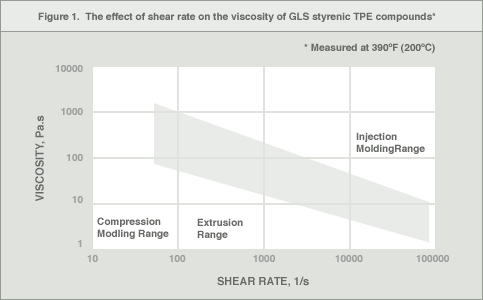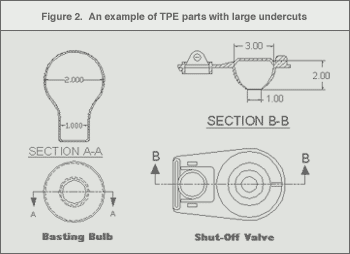SBC Rheology
- SBCs are shear dependent – this means their viscosity is higher at low shear rates (such as extrusion) and lower at high shear rates (as in injection molding).
- SBC TPEs will flow more easily into thin areas of the mold at high shear rates.
- The shear thinning behavior of SBCs should be considered when designing injection molds and also when setting mold conditions during processing.
The figure below illustrates the effect of shear rate on the viscosity of GLS styrenic TPEs (measured at 390°F (200°C)).

To obtain information regarding the viscosity of an individual grade, refer to the Product Technical Data Sheet.
General Concepts
When designing a TPE part, there are a few general rules to follow:
- The part wall thickness should be as uniform as possible. Transitions from thick to thin areas should be gradual to prevent flow problems, back fills, and gas traps.
- Thick sections should be cored out to minimize shrinkage and reduce part weight (and cycle time).
- Radius / fillet all sharp corners to promote flow and minimize no-fill areas.
- Deep unventable blind pockets or ribs should be avoided.
- Avoid thin walls that cannot be blown off the cores by air-assist ejection.
- Long draws with minimum draft may affect ease of ejection.
Flow Length and Wall Thickness
The maximum achievable flow length is dependent on the specific material selected, the thickness of the part, and processing conditions. Generally, GLS TPEs will flow much further in thinner walls than other types of TPEs.
The flow to thickness ratio should be 200 maximum, however this is dependent on the material and the part design. High flow GLS TPEs (such as Versalloy) have been used successfully to fill flow ratios up to 400.
The measurement of spiral flow offers a comparative analysis of a material's ability to fill a part. The spiral flow test is performed by injecting a material into a spiral mold (similar to a ribbon formed into a spiral). The distance the material flows is measured in inches.
In this case, the spiral flow test was conducted using two different injection speeds (3 in/sec and 5 in/sec). The typical spiral flow lengths for the various GLS product families are summarized in the table below.
Table 1. Typical spiral flow lengths for GLS TPEs*
|
Series
|
Flow Length, in
|
|
Injection velocity, 3 in/s
|
Injection velocity, 5 in/s
|
|
Dynaflex™ D
|
13-15
|
18-20
|
|
Dynaflex™ G
|
12-22
|
18-30
|
|
Versaflex™
|
9-16
|
13-26
|
|
Versalloy™
|
18-20
|
30-32
|
*Spiral flow tests performed using 0.0625" thick x 0.375" wide channel at 400°F.
For spiral flow information about a specific grade or additional details about the spiral flow test procedure, please contact your Avient representative.
Undercuts
The flexibility and elastic nature of SBC TPEs allows for the incorporation of undercuts into the part design. Because of their excellent recovery characteristics, GLS TPEs are capable of being stretched and deformed, allowing them to be pulled from deep undercuts (as shown in the figure below).
If both internal and external undercuts are present on the same part, slides or core splits may be necessary. Parts with internal undercuts (e.g., bulb-shaped parts) may be air ejected from the core by use of a poppet valve in the core. Minor permanent elongation (3% - 8%) due to deformation may occur during ejection.

Gate and Knit Line Locations
The product engineer should indicate the areas of the part that are cosmetic and those that are functional and include this information on the drawing. This will help the mold designer to determine the allowable gate and knit line locations.
Anisotropy
- Thermoplastic materials that have different properties in the flow direction versus the cross-flow direction (90° perpendicular to the flow direction) are characterized as "anisotropic" materials.
- Properties that may be affected are shrinkage and tensile properties.
- Anisotropy is caused when the polymer chains orient in the direction of flow, which leads to higher physical properties in the flow direction.
- Wall thickness, injection speed, melt temperature and mold temperature are a few variables that affect anisotropy.
- Depending on the processing conditions and mold design, most GLS styrenic TPEs exhibit a degree of anisotropy.
Shrinkage
Due to their anisotropic nature, GLS TPEs shrink more in the flow direction than in the cross-flow direction. Generally, SEBS TPEs have higher shrinkage and are more anisotropic than SBS TPEs.
Typical shrinkage values for SEBS-based TPEs are 1.3% - 2.5%, whereas those for SBS based TPEs are 0.3% - 0.5 %. Softer SEBS formulations (below 30 Shore A) will shrink more than harder materials. Some grades, such as OnFlex™ G7700s and G7800s, and Dynaflex™ G7900s contain filler, which reduces their shrinkage.
The shrinkage values reported by Avient are determined using a 0.125" thick plaque. It should be noted that shrinkage is not an exact number, but a range value. This range can be affected by the part wall thickness, melt temperature, mold temperature, injection speed, hold/pack pressures and also the time between molding and measuring. As a result, prototyping is strongly recommended for parts with close tolerances to better quantify the realistic shrinkage of a specific grade of material in the application.
For shrinkage values for specific grades, please refer to the product technical data sheet.


